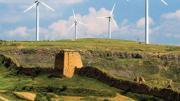Environmental scientists have concluded that China could meet its electricity needs through 2030 with wind power alone. In their study, the cover story in the September 11 issue of Science, lead author Michael McElroy, Butler professor of environmental studies, and colleagues from Tsinghua University, working as part of Harvard's China Project, conclude that a network of wind turbines operating at just 20 percent of their rated capacity could produce as much as seven times China's current consumption. China is currently second only to the United States in its national power-generating capacity, and is the world's fastest growing market for wind power. McElroy wrote a feature article for Harvard Magazine on the electrification of the United States's transportation infrastructure and the viability of wind power. His Harvard colleagues have also worked extensively on the problem of air pollution in China.
Wind Powering China
Wind Powering China
China could produce seven times its current electricity needs using wind alone.

You might also like
A Congenial Voice in Japanese-American Relations
Takashi Komatsu spent his life building bridges.
Why Harvard Needs International Students
An ed school professor on why global challenges demand global experiences
Free Speech, the Bomb—and Donald Trump
A Harvard cardiologist on the unlikely alliances that shaped a global movement to prevent nuclear war
Most popular
Explore More From Current Issue

For Campus Speech, Civility is a Cultural Practice
A former Harvard College dean reviews Princeton President Christopher Eisgruber’s book Terms of Respect.

Harvard’s Financial Challenges Lead to Difficult Choices
The University faces the consequences of the Trump administration—and its own bureaucracy






